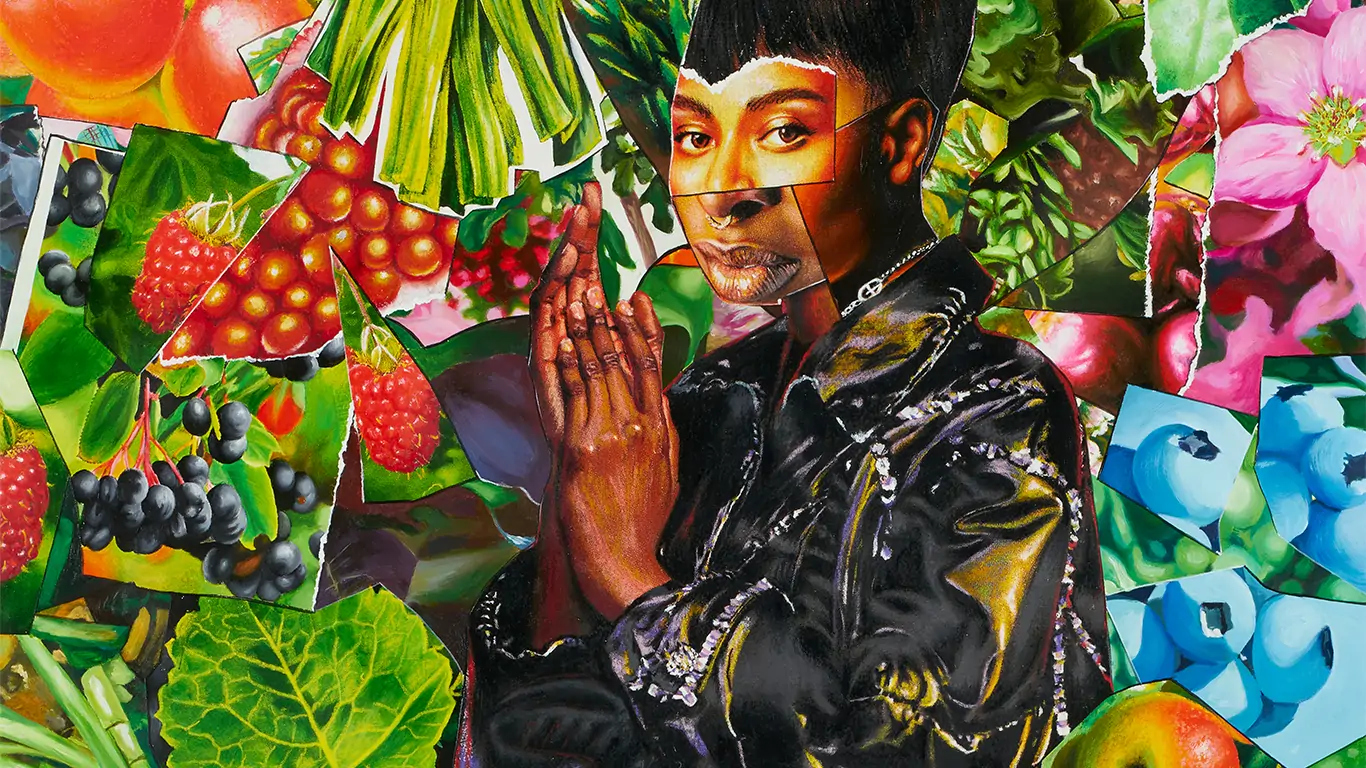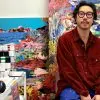Only a few artists can elevate the meaning of art to new heights, and Ghanaian multimedia artist Larry Amponsah stands out as an example; his work is a tantalizing enigma wrapped in aesthetic delight that commands attention. It’s a spectacular amalgamation of the traditional and the avant-garde. Amponsah provides a critical lens through which the politics of contemporary imagery are not merely viewed but engage the senses and intellect with equal vigour. Throughout his practice, Amponsah probes the systems of power images hold, striving to forge pathways that exceed cultural and societal limitations.
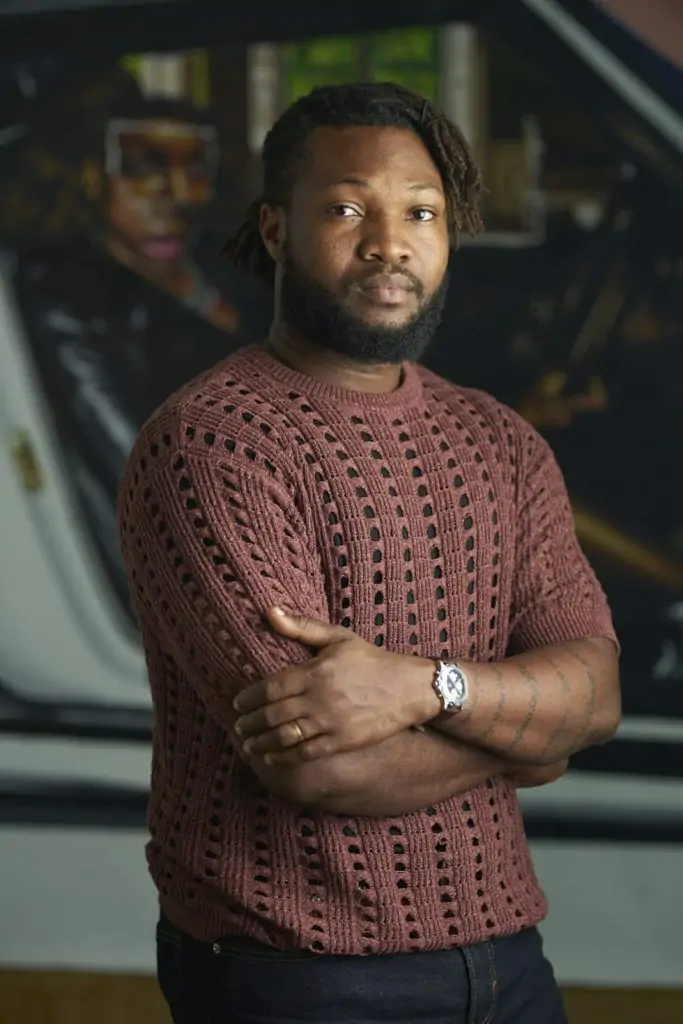
Image courtesy of the artist and Gallery1957
As Gaston Bachelard said “when the images of the present do not change, we must change the images of the past” … in a way, that’s what I’m doing.
Larry Amponsah
Amponsah initially trained as a painter and then transitioned to conceiving his visual dialect. He constructs this dialect by intentionally borrowing and altering preexisting images, objects, and ideas from magazines from various cultures, all while his painting skills guide the process. Inspired by his cultural heritage and global influences, Amponsah interweaves his personal experiences into the broader narrative of his work.
We experience Amponsah’s dialect in his piece “For Her Sake,” featured in the upcoming group exhibition at London’s 1957 Gallery. It’s a sophisticated puzzle, like a Rubik’s Cube, where Amponsah’s combinations of elements intersect to assemble his depictions. We see Amponsah’s symbolic intertwining of humanity with Mother Nature, shrouding his figure in flora, standing in stark contrast to their effervescent background, hands gently clasped, signifying a state of anticipation or the act of waiting to receive.
The interplay of texture and colour in this piece, along with the charm of traditional painting—from the glossy finish of the figure’s garments to the almost tactile representation of leaves and petals—invites you to not just see the art but to feel it!
Amponsah acknowledges the importance and sacredness of visually representing the Black body, challenging the attached stereotypical narratives. Yet, his work also unearths buried history (of African descent), shining light on silenced Black realities and crafts new histories inviting independent contemplation, which poses a unforgettable challenge to the dominant powers of representation.
We managed to catch up with the artist ahead of his participation in the group exhibition ‘Constellations, Part 1: Figures on Earth & Beyond‘ at Gallery 1957 in London. The exhibition celebrates creative communities in Ghana and the UK, bringing together a roster of established and emerging artistic talents. In this interview, we learn more about Amponsah‘s practice, inspiration, and more.
Hi Larry, how are you doing? could you share your journey into the arts and what motivated you to pursue a career in arts?
Larry Amponsah: It’s a long story, but let me give it a go: As a kid, my dad always wanted me to be a pilot so that I could serve in the Ghana Air Force when I was of age, but I think my destiny had already been sealed even before I came into existence by my creator. Growing up, I loved mark making and drawings, especially when they ended up looking like things people could read and understand like a bird, flowers, a house or the human head; I received a lot of praises for my early drawings in primary school from my mates and teachers, and I loved that so it kept me going. Reality hit me when I was about to enter Senior High School and started to think about what to really do for a living. That was when fear crept in as I kept hearing from people I trusted and respected that it was hard to earn a good living as artist in Ghana.
So, I changed my mind, and instead of choosing Visual Arts, I went on to pursue a course called General Arts, which was to train me to become a historian, politician, TV presenter or news reporter. Three months into the course in High School, I realised how boring it was for me, so I started making sketches of my classmates, and soon enough, they realised how talented I was. I did a drawing in class one day as a teacher was teaching a subject called Government. Whilst shading the work, a friend took it from me and passed it around for everyone to see, including the teacher. Then, they all started to convince me to go to the Visual Arts class where I belonged.
I kept dragging my feet but three days after that, a friend of mine in class called Andrew Anthony physically took my hand and sent me straight to the Visual Arts Class. The teacher there saw my works and went with me to see the School principal to change my course from General Arts to Visual Arts… and here I find myself as an artist, making change for myself, my community and the art world at large. So, I think my career as an artist was meant to be, and I’m eternally grateful for how it all came together.
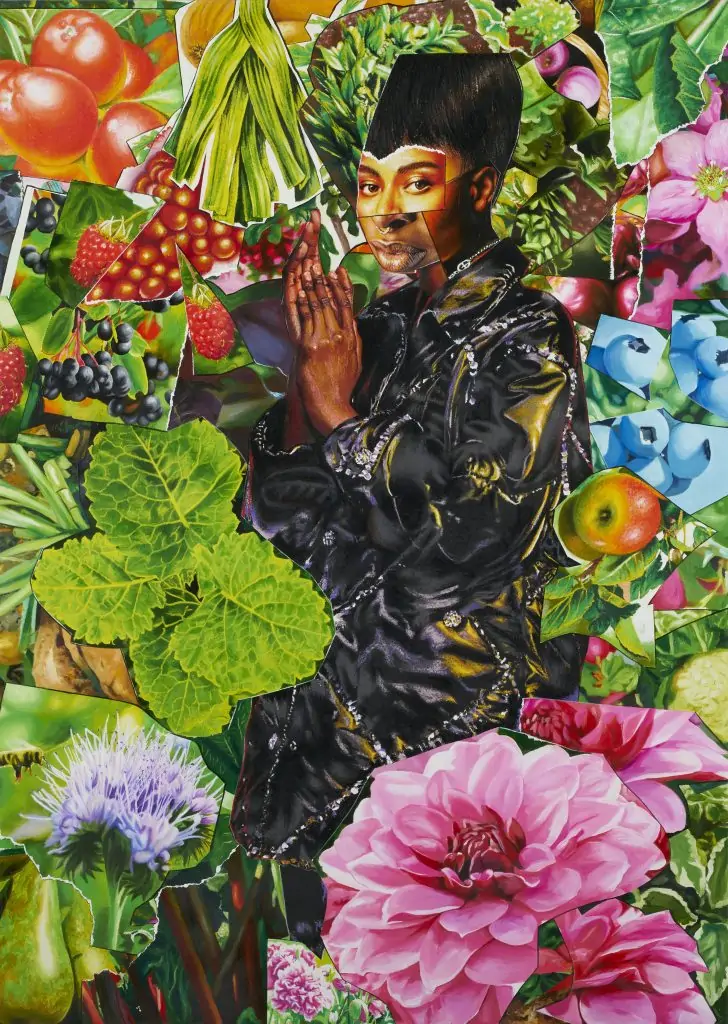
For her sake; And, when the heavy night was shifted by the bright rays of day, the stars, millions of them miraculously turned into the abundance we seek, all for her sake, 2023, oil paint,
oil pastel, acrylic paint & print on canvas, 100 x 140 cm,
courtesy of the artist and Gallery 1957
Your practice, which encompasses collage, photography, print, painting, and digitization, explores the politics of portraiture and the representation of the black body in global art. Could we delve more into your practice, inspirations, and thematic focus?
Larry Amponsah: I do figurative art, yes! But the question is, what type of figuration am I on? Is it merely the human figure I am exploring? No! One thing for sure, is that through my practice, I am constantly trying to figure out how to create a formidable shouting voice, a voice that can’t easily be ignored, a voice that provokes and teaches.
I’m figuring out the best possible ways to question the prevailing authorities in the production of images (which become the basis on which our primary understanding of how one must operate is formed in this world of ours), making them the most powerful and important element of change, but also finding ways to solve the unresolved questions or representation.
So, I focus very much on the environment in my paintings and the objects within them. The black body only comes into the picture to add a touch of reality (my reality) to my works and to lock them in the exact position I want them to be in order to help people see the works the way I want them to be seen. So, my practice extends beyond the black body; it excavates buried history (of African descent), highlights silenced black realities, and, in most cases, creates new histories.
In focusing on the politics of portraiture, how do you navigate the complexities of representing the black body within a historically Eurocentric global art context?
Larry Amponsah: Through the power of imagination and fiction, I reinterpret the black body by listening closely to my personal desires. I tend to question myself a lot you know, how do I see myself, how do people see me, how do I want people to see really see me and my people? And in trying to tackle these questions and many more, I create works that seek to revive the black image to its truest form, to renegotiate some of the terms through which blackness is seen. As Gaston Bachelard said “when the images of the present do not change, we must change the images of the past” … in a way, that’s what I’m doing.
Building on this, your work fuses aesthetics from art history, contemporary social media, and advertising. How do these diverse influences shape your creative process, and how do you ensure they harmonize rather than conflict in your work?
Larry Amponsah: In an image proliferated world, I believe new images can be forced out of the old. Millions if not billions of images are made daily, and when all the power of one’s mind and the incredible mysteries in already existing images can be manipulated and reconfigured into infinite possibilities, all one needs to do is to understand and really master their language of making and then find fresh and effective ways to speak that language with clarity. When starting out with dedication, hard work and a lot of sacrifices, it all begins to make sense.
The complex paintings I make tend to work well with the eyes because they are not accidental. Everything you see in the painting is there because I want it to be there. My works are mathematical, they borrow formulas of addition, subtraction and even multiplication to find ground in the complexities of time, space, history, politics and experiences, and collage for me is the only mode of execution that can make this possible. Collage fascinates me a lot because it allows me to slow things down in order to see the bigger picture – I always say the world is a giant collage constantly making and unmaking itself. I’m just the guys with the authority to freeze some of these beautiful and radical moments for us to see as the shift happens.
The faces in your portraits are often described as multi-dimensional, both physically and psychologically. Could you elaborate on your techniques and intentions in creating these layered facial representations?
Larry Amponsah: Well, for me time is not linear and nor are history, memory, imagination, and the very foundation of our identity (which I find very questionable). We are not as disjoint as we are made to believe. We are connected, joined together by a single unseen thread, and that’s why collage means a lot to me: it helps to convey this idea of interconnectedness with clarity whilst disrupting, complicating and extending the black body in order the reveal what blackness really means to me in contemporary terms.
By sampling and working with what is available to me, I prove that not only are there many spectrums of black, but also that black can be as white as can be and vice versa… I am interested in that fluidity. Using the readily available images gives me more freedom to explore a bigger world. I believe that my travels have taught me one thing and it’s that wisdom does not reside in one head and nor does knowledge… for it is too vast to be found in one place. One must search everywhere for it on a deliberate quest. Doing that has added more weight and meaning to my work.
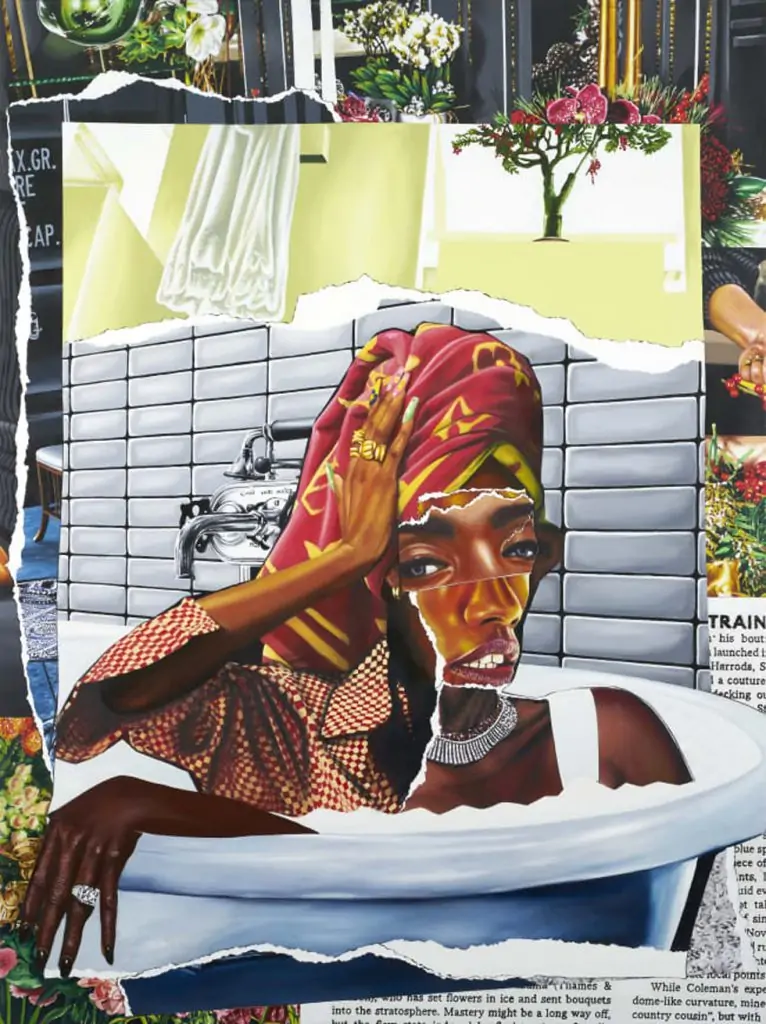
150cm x 200cm, Oil paint, oil pastel, acrylic paint and print on canvas.
Image courtesy of the artist and Gallery 1957.
Additionally, your work incorporates universal symbols, ranging from leaves to bags. What is your process for selecting these symbols and their roles in the narrative or message of your portraits?
Larry Amponsah: Aside the seriousness of my practice, I make sure that there’s something for everyone in my work – from simple objects to extravagant ones, from thought-provoking discourse to comedy, from the everyday image to prophetic declarations of representation. These are all there. I like to use semiology to stimulate the minds of my audiences and there is a place for that too, haha. In contemporary art, there is place for complexities in as much as there is for simplifications.
I choose the complex stuff because I love challenges. I tell people that everything is art, but they cease to be art when they are understood. Good art is mysterious, surprising and always refreshing – one must sense something when they see art (the sensation could be good or bad but it doesn’t matter really). The moment we think we understand art, we lose that sensational reward, and that’s when the power and essence of that art dies and slowly manifests into a mere commodity. So, some of these symbols are there to complicate the conversation, to erase all simplistic readings of my work and to add to the mysteriousness of the work.
How has your artistic style evolved over time, and what have been the key influences or pivotal moments in this evolution?
Larry Amponsah: Everything in life strongly tell us that change is constant and inevitable, and so does my practice. I deliberately strive for change in my work as an artist. It’s not easy to choose the kind of practice I have subjected myself to – to solve the unresolved questions of representation in history and to create a space within that same history for my practice to fit. You have to be at your best to make this almost impossible dream possible, one must become an inventor to be successful and that’s exactly what I’m doing… inventing! So yes, my stale has tremendously evolved over time and it’s because I like setting new challenges for myself and overcoming those challenges and that cycle over and over again with new sets of challenges.
I used to make only physical hands-on collages, then I introduced paint, and now a whole new technique which was developed as a result of the Covid 19 pandemic and the lockdown that came with all the limitation it placed on mankind. All that didn’t suppress my creativity because I was quick to realise that even in crisis and absence creativity abounds. It was when I created some of my most radical paintings, which I have carried on expanding more and more into the kind of paintings I am making today.
I am heavily influenced by phenomenon occurrences and how I can depend on those phenomena to expand and reinterpret our reality in a way that satisfies my personal needs and the desires of my people, through the language of painting and my total dependence on the promises of fiction, and the authority of my own imagination. For me reality as it is, is never enough… it just isn’t, especially for people like me (black people).
There is a bigger responsibility at play here and for this reason change becomes my only trusted friend on whom I rely. In fact, I love how Katherine Finerty (currently Project Curator in International Partnerships at Tate) puts it “In keeping with Larry’s enduring search for ever-evolving technical mastery and metamorphoses, we see painting reinvent itself”.

He Is No Alien To Me, 2022
Collage, print, oil pastel and acrylic paint on canvas
67 1/10 × 51 4/5 in | 170.5 × 131.5 cm
Your work will be featured in the group exhibition ‘Constellations, Part1: Figures on Earth & Beyond’ at Gallery 1957 in London. The exhibition celebrates creative communities in Ghana and the UK. Can you tell us more about how your work fits into the exhibition’s essence?
Larry Amponsah: The work is called “For her sake; And, when the heavy night was shifted by the bright rays of day, the stars, millions of them, miraculously turned into the abundance we seek, all for her sake”. It’s a poem I wrote, and it examines the number of like-minded people that come together, and the level of rules that must be changed for black women (on whom the entire black race depend to survive) to live in peace and thrive.
Communities are important to me, first as a Ghanaian, then as an artist. When people come together, the heavens tremble, and hell is vanquished. So, the work is very strong because it is a powerful declaration, calling on all black practitioners far and wide to let go of all the unaffordable luxury and focus on the kind of change we can bring to our communities when we come together and reason in one voice towards one direction.
Amidst the abundant distractions and external pressures of the world, how do you sustain your creative rhythm while embracing the unpredictable and recursive nature of artistic creativity?
Larry Amponsah: By staying positive and open-minded, with all the difficulties and hardships in the world both publicly and in our private lives and spaces, it is significantly crucial to try not to be binary… we must all force ourselves to form and hold different views and beliefs and our minds must be prepared and open wide enough to allow these thoughts to linger freely. It’s the best way forward! I want my works to bear the power to make my audience see the world and the people in it anew… like it was their very first time encountering this old world we live in.
I think the responsibility of being an artist is to make people understand the world in a whole new way… to make people see our world at a larger scale, like eagles see it. Only then can they make to connections meaningful to them.

Are there any themes or techniques you are excited to explore in your future work? How do you see your art contributing to the conversation about race, identity, and representation in the art world?
Larry Amponsah: Yes, there are so many themes I want to explore. Due to new resources and technology that have become available, I plan to test more ideas over the coming years. The first one I want to share is a collaboration I plan to do with a software engineer friend: to use AI and VR to reimagine my work and to make a body of VR works that people can almost walk into and spend time in to engage with the characters and to explore the worlds, I strive to create so that they leave with an unforgettable experience. I’m excited about the future and can’t wait to share more with my audience soon.
Lastly, please share your thoughts on what art means to you and how it impacts your life and work.
Larry Amponsah: Art has for the most part been a key element in the fabrication and re-fabrication of our evolution as humans. We have depended on it for as long as we can remember and our structures of progress bear testimony to how we have always depended on art to understand our environment, make meaning of who we are, and to reimagine our world anew, as our hunger to progress and sustain the Earth keeps growing.
Right from the Prehistoric era, when the idea of sympathetic magic was used through cave paintings as a way of empowering and aiding human survival, to our current world of numerous struggles for justice. Equally, through protests and activism, art has always been instrumental in helping us achieve our goals and has encouraged humanity to do better by demanding more from themselves and from those in authority. Art occupies a unique position to trigger change in all parts of our world today. I mean, think about the fact that racial segregation and inequality as an idea started on the basis of looks and differences in human anatomical structures, and for these ideas to gain ground, artists and scientists were employed to make images that could push that agenda to convert the oppressor and the oppressed to both believe that racial segregation was a necessity in civil society.
If art has the power to make us believe in an idea this false, it means if we learn how to use art well and create the right images there is nothing we can’t get through as a people. Unfortunately, art is usually weaponised (in religion, politics and education) as an instrument of oppression by those in authority. But I am happy that artists have realised their power and position in society and are now using their work to fight and decolonise many of these systems of oppression and injustices we see today, making art a beacon of hope. I am in no doubt optimistic that with a collective voice, we can make our world a better and safe place to live.
©2024 Larry Amponsah


